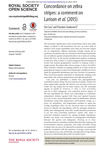Please use this identifier to cite or link to this item:
http://lib.hpu.edu.vn/handle/123456789/23693Full metadata record
| DC Field | Value | Language |
|---|---|---|
| dc.contributor.author | Caro, Tim | en_US |
| dc.contributor.author | Stankowich, Theodore | en_US |
| dc.date.accessioned | 2016-10-11T05:37:53Z | |
| dc.date.available | 2016-10-11T05:37:53Z | |
| dc.date.issued | 2015 | en_US |
| dc.identifier.other | HPU4160610 | en_US |
| dc.identifier.uri | https://lib.hpu.edu.vn/handle/123456789/23693 | - |
| dc.description.abstract | The functional significance of the extraordinary black and white stripes of zebras is still mysterious but now an active field of research. Four major hypotheses have been put forward: stripes are an antipredator defence operating through crypsis [1]or confusion of predators [2], are a means of reinforcing social bonds [3], are defence against ectoparasites [4] or are a means of cooling zebras [5]. Now, in the second multifactorial analysis of striping in zebras to date, Larisonet al.[6] investigated the environmental factors that explain geographical variation in striping within a single species, the plains zebra (Equus quaggaorEquus burchellii) | en_US |
| dc.format.extent | 4 p. | en_US |
| dc.format.mimetype | application/pdf | - |
| dc.language.iso | en | en_US |
| dc.subject | Biology | en_US |
| dc.subject | Concordance | en_US |
| dc.subject | Zebra stripes | en_US |
| dc.subject | Larison | en_US |
| dc.title | Concordance on zebra stripes | en_US |
| dc.type | Article | en_US |
| dc.size | 276KB | en_US |
| dc.department | Education | en_US |
| Appears in Collections: | Education | |
Files in This Item:
| File | Description | Size | Format | |
|---|---|---|---|---|
| 0493_Concordanceonzebrastripes.pdf Restricted Access | 276.77 kB | Adobe PDF |  View/Open Request a copy |
Items in DSpace are protected by copyright, with all rights reserved, unless otherwise indicated.
